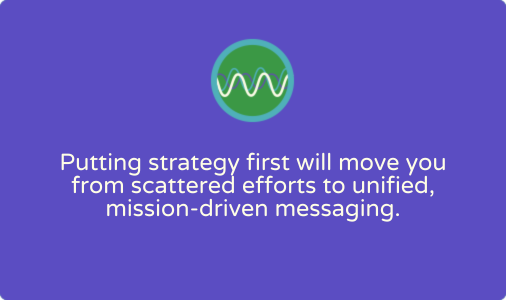“We need to put more order into our communications. To increase the impact of our comms, we need everything working together: channels complementing each other, and clarity on roles and responsibilities.”
The executive director of a nonprofit organization recently shared this statement with me as we prepared for a communications audit. It’s a familiar frustration for many nonprofits: communications feel scattered, reactive, or disconnected. The team is busy producing content and running channels, but the results don’t reflect the effort, and instead of clarity, there’s confusion.
The root of the problem: a lack of strategic alignment
Misaligned communications often come back to one thing: there’s no clear link to the organization’s strategy. Lack of coordination is often a result of jumping straight into tactics (channels, campaigns, content) without a clear strategic foundation.
Without a strategic foundation, every new request, project, or idea feels equally urgent. When strategy isn’t the starting point, communications become reactive and fragmented. Content gets created in response to internal pressures rather than audience needs. Channels compete instead of complementing each other. Your audiences struggle to understand who you are and why your work is important. And team members are left wondering: where do we focus?
That’s why strategy needs to come first.
Communications are most effective when they’re an extension of organizational priorities. Your nonprofit’s strategy determines your communications goals and audiences. Messaging translates your priorities into what to say and how to say it. Content and channels are directed by strategy and messaging — not the other way around.
How to bring strategic alignment into your communications
So, what does it mean to “put strategy first?” Because my work with nonprofit communicators centres around messaging and content, strategic nonprofit communications means looking at the following:
- Brand messaging
Your nonprofit’s brand messaging platform is the framework that connects your organization’s overarching, strategic priorities to what you need to say and how you say it. Consistently using your brand as a framework ensures that whether you’re writing a web page, a report, or a social post, your content remains consistent and strategically aligned. - Audiences
Your communications need to reach and resonate with the right people, which is why I always bring the conversation back to who you’re trying to connect with, how you’d like to engage them with your work, and how communications can move them to action. When you prioritize audiences and centre them in your communications decisions, you can make smarter choices about content, channels, and tactics. - Content priorities
It’s essential for nonprofit communicators to identify which content is most important and worthy of your limited time and resources. Setting clear priorities helps you focus on developing the elements that support your mission — and help keep you from being pulled in multiple directions.
Reflection questions: strategic nonprofit communications
If you’re feeling the weight of scattered communications, start by asking:
- How well does our communications strategy connect to our strategic plan?
- Are we consistently using our brand messaging to guide creative decisions?
- Who are our priority audiences? Are we reaching them?
- Are we developing the right content elements?
Answering even one of these questions can help clarify where to focus next to bring channels and team members into alignment and to develop content that serves your mission, rather than distracting from it.
Moving forward
I recently refreshed my own brand messaging to ensure it reflects the strategy-first approach I’ve been bringing to nonprofits for years. The exercise has helped me with content creation and updates, which you’ll see reflected here on my website (including my home and about pages.
If you’d like to learn more about how I can help you align your nonprofit’s strategy with stronger messaging and content, check out my full range of services. Or, for a quick consultation and reset option, see my priority content assessment.
Whether or not you’re ready for outside support, I encourage you to keep coming back to this question: how do our communications connect to our strategy? It’s the single most powerful way to bring order, focus, and impact to your nonprofit’s communications.




